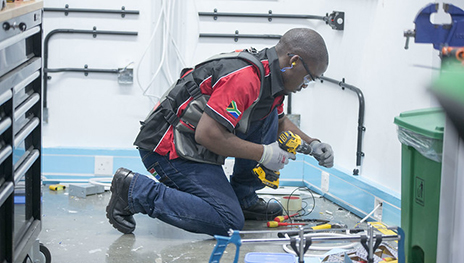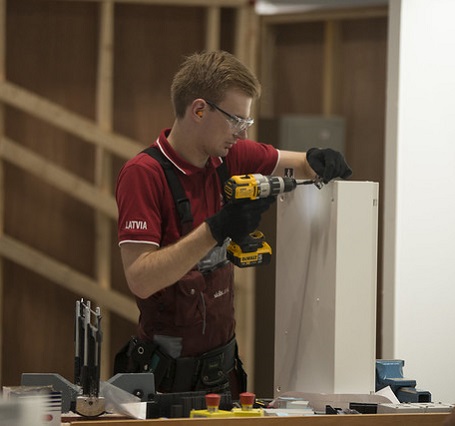ELECTRICAL INSTALLATION COURSES
Does working in electrical technology spark your interest? There’s a lot to be excited about. Renewable energy and smart heating are among the big topics of the moment,
Whether it’s powering people’s homes or working on large-scale energy projects, there are lots of jobs in the sector that will be in demand – in or out of a recession. Our hands-on electrician courses will help you develop the skills to become a qualified electrician. With lessons taking place in an electrical workshop that’s been built to industry standards, you’ll learn about all of the required electrical principals and installation techniques.

HOW TO REPRESENT THE ELECTRICAL INSTALLATION OF A HOUSE
The electrical installation of a house or building is one of the key points of its structure. It must comply with a series of regulations and technical specifications that guarantee its installation and operation. You will agree that an electrical installation must be configured according to safety and comfort criteria that ensure the optimum operation of the installation. To represent an electrical installation there are different alternatives. In this case, we will focus on one of the most common and currently used: the single-line diagram
WHAT IS A SINGLE-LINE DIAGRAM
The single-line diagram is a graphical representation of an electrical installation. It differs from other diagrams because, in the case of the Single Line diagram, each circuit is represented by a single line, in which all the conductors of the corresponding section are represented.
BASIC ELEMENTS OF A SINGLE-LINE DIAGRAM
Following the standard electrical symbolism, the basic elements of the installation will be represented in the single-line diagram. In some of them we could even find more sophisticated elements, more typical of more complex schemes.
DISTRIBUTION PANEL
The distribution panel contains the elements for the protection and control of the electricity supply of the house. The electrical system is organized from this panel and the power of the installation is distributed. In the single-line diagram the electrical panel is usually represented by a rectangle drawn with a dotted line.
CIRCUITS
A regular house usually has at least 5 circuits. In the single-line diagram we will see them represented as a line in which all the conductors are included. The top end usually corresponds to the start of the scheme. The lower end is usually connected to another circuit or to a receiver.
First circuit: controls lighting and illumination (intensity 10A)
Second circuit: shows most of the plugs (16A current)
Third circuit: represents the kitchen and bathroom sockets (intensity 16A)
Fourth circuit: for the oven (intensity 25A)
Fifth circuit: it brings together the washing machine and washing appliances (intensity 20A)
ELECTRICAL RECEIVERS
Electrical receivers represent all devices that are plugged in, whether they are thermal, such as stoves, irons, ovens, etc.; or luminous, such as lamps
POWER CIRCUIT BREAKER
The function of the Power Circuit Breaker is cutting off the flow of electricity to the installation in the event of a short circuit or an overvoltage. This switch monitors that the maximum bearable by the installation is not exceeded

Electrical installations in residential buildings
Infrastructure of electrical installations
Electrical conduits are the infrastructure of electrical installations. Building technology is one of the construction stages of a house which is used longest – mostly for the entire life of the building. Those who want to install only the minimum equipment in the new building for cost reasons should plan ahead and include several conduits
A professional retrofit installation of cables in the wall causes dirt and is disproportionately expensive. In addition, this is hardly possible in concrete walls. Frequently, conduits show their true value years later when owners and tenants consider buying new technical gadgets
This is why a well-planned, comprehensive installation of conduits assures the builders already at the construction stage that they can always use new technologies in their home – and this with very little installation effort. Renovation and modernisation should also be used in existing buildings to install conduits to make the house ready for the future. Electrical conduits are the right investment to make residential property future-proof and are sure to pay off in the long run.
first provider to launch eco-balanced electrical conduits, and pledges itself to ecological sustainability in construction. The eco-balanced co2ntrol conduits reduce the consumption of fossil resources by up to 60 percent and save approx. 47 percent CO2. In order to render the co2ntrol products CO2-neutral, plants trees in its home region that bind and continuously store the remaining CO2 of the product group.

Electrical Installations
Electricians design and install electrical systems in all types of commercial, residential, and industrial projects, while carrying out maintenance and repairs safely and quickly. Electrical equipment and systems may include switchboards, cables, fuses, thermal relays, fault current protection switches, heating, lighting, air conditioning and metering equipment as well as crime and fire alarm systems.
Work organization and self-management, communication and interpersonal skills, concentration and attention to details, problem solving, flexibility, and a deep body of knowledge are the important attributes of outstanding electricians. Given the risks associated with electricity, offering a safe and reliable service to customers is paramount. Electricians need to have an intimate knowledge of the latest safety standards and work to a strict code of safety conduct.
Electrical installation is closely associated with other parts of the construction industry, and electricians find themselves working in all manner of commercial, residential, agricultural, and manufacturing environments. Increases in the construction sector and growing demand for alternative energy sources will drive demand for electricians.
Electrical equipment accessories for professionals
Professional and skilful electrical installation requires not only well-trained specialists, but also well thought-out electrical equipment products. To help electricians and engineers make their work more safe and efficient, constantly developing practical solutions for all types of electric installation.
only high-quality materials with a long service life are used to ensure that the respective electrical installation fulfils even the highest safety requirements and is durable. As an example, particularly the safety aspect electrical equipment installations is taken into account at a very early design stage of individual products.
The transparent push-in wire connectors from the series allow visual inspection of the connection – an important safety feature for the inspection and approval of electrical installations. Likewise, the expert for electrical installation includes various structural demands in its planning. Therefore, our portfolio also includes push-in wire connectors that can be used on-wall or flush-mounted and in all kinds of junction boxes
Within electrical installation the main applications of are the insulation, fixing, bundling, sealing and marking of wiring. Various sizes, colours and materials support the professional use in electrical installation: as a fast, reliable help for repairing cables, as a tool for sealing connection points, as a warning for temporarily laid wiring or as a clearly visible cable marker. Thus, the PVC Flex insulating tapes are coated with adhesives that are specially adapted to the respective application areas, emphasising their mechanical properties for electrical work
multi-functional tool that simplifies any kind of cable routing. These cable rods are available in various sets, each consisting of a robust case and a large number of useful accessories. Extensions, adapters, hooks, guide eyelets, lights, magnets and cable grips make the cable installation system a universal tool. With the help of fiberglass-reinforced rods, cable routing is much easier even in installation areas that are difficult to access, so that their use ensures considerable time savings.